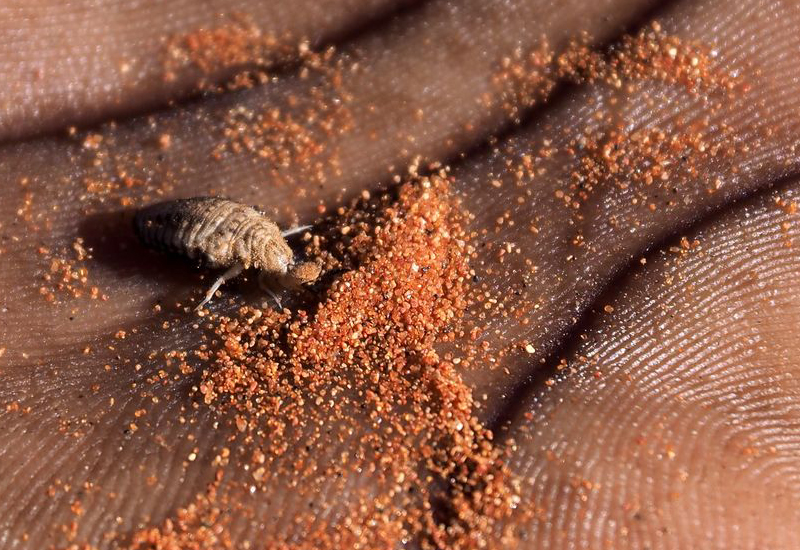Mud houses, an architectural marvel in the insect world, are structures built from mud and other natural materials.
These homes serve as protective nests, breeding grounds, and food storage sites for various insect species.
In this article, we’ll explore five fascinating insects known for constructing mud houses.
1. Mud Daubers: Most Well Known Insects That Build Mud Houses
Mud daubers, a type of solitary wasp, are renowned for their unique mud nests.
These insects gather mud and sculpt it into various forms, from elaborate tube-like structures to simple plasters over cracks and crevices in wood, stone, or masonry.
Unlike social wasps like yellow jackets or hornets, mud daubers live alone and do not defend their nests aggressively.
They build a range of nests, including multiple tubes or small vase-like nests attached to plant stems.

2. Termites
Termites are renowned for their large, complex mud houses, especially in tropical regions.
The Formosan subterranean termites build underground colonies.
With about 2,000 species globally, these insects demonstrate extraordinary teamwork in their colony’s caste system.
These insects are known for their large, complex mud houses, especially in tropical countries.
A termite colony is divided into three castes: reproducers, soldiers, and workers.
Workers, the most active group, are responsible for maintaining and expanding the nest, which can reach up to twenty-six feet tall in some species.

3. Potter and Mason Wasps: Nest Builders
Potter and mason wasps, similar to mud daubers, use mud to build their nests. These insects gather mud from moist areas to construct homes for their young.
Their nests can often be found attached to various surfaces and resemble small clay pots or tubular structures.

4. Antlions: Hunting Strategy
Antlions, also known as doodlebugs, are unique in their use of mud. They create cone-shaped sand traps to capture prey.
By burying themselves and using their heads and jaws, antlions transpose sand to the surface, forming these traps which can grow up to 8 inches high.

5. Cicada Killer Wasps: Nesting Habits
Female cicada killer wasps dig tunnels in bare, sandy soil to create their nests.
These nests are often accompanied by mounds and can be found in groups near garages, patios, and other dry, sandy areas.
6. Ants: Underground Nests
Certain ant species, such as fire ants, army ants, citronella ants, and leafcutter ants, construct mud tunnels.
These tunnels serve various purposes, including protection from predators, maintaining suitable temperatures, and building nests and colonies

7. Crayfish: Mud Covered Mounds
Crayfish, found near rivers, lakes, and streams, construct their homes by digging burrows into mud banks.
They create mud-covered mounds known as chimneys, providing shelter from predators and a place for laying eggs.
These mounds, often seen in wetlands and swamps, are essential for creating a safe and stable living environment for crayfish
Conclusion
Insects building mud houses display a fascinating aspect of nature’s creativity and ingenuity.
From the solitary mud dauber to the community-driven termites, each species has a unique approach to using natural resources for shelter and survival.
Understanding these insects helps us appreciate the complexity and diversity of the natural world.
Reader Emails
Over the years, our website, whatsthatbug.com has received hundreds of letters and some interesting images asking us about insects that build mud houses. Scroll down to have a look at some of them.
Letter 1 – Mud Ball Mystery
mudballs
Location: N. California, Sutter County, Sutter Buttes, valley oak woodland
March 5, 2012 2:27 pm
What is the story behind this photo? Taken Feb 2012 in a small valley in the Sutter Buttes, Sutter County, Northern California. I was thinking solitary bee or trapdoor spider?
Signature: JD

Dear JD,
While we are not certain what created this Mud Ball Mystery, we are relatively confident it is neither a Trapdoor Spider nor a Solitary Bee. Could you tell us a bit more about the terrain? Was this an area that floods in the spring? It reminds us a bit of a Crayfish burrow.
Some Comments
I cannot imagine that this is a crayfish burrow. As I remember both of the burrows we saw are in a veg area classified as California Prairie or Blue Oak in rather stony (about 30% up to fist sized cobble sub angular to angular) areas that I do not think flood in the spring. Would you agree with me Michael and Zack? Thanks for following up on this Jim. Leslie
Definately not crayfish, I saw two more at about 1000 feet elevation the other day.
Zack
Hi Daniel,
I concur with comments below (Ed. Note: comments above) that this is far too dry environment for a crayfish. I will be in the field soon to get more photos with a ruler for scale, some capture tools.
What additional information is needed and how do I go about obtaining it – e.g. pour water into the hole to encourage the critter up to show itself? I would rather not be too destructive in the investigation, so I am a bit reluctant to excavate the hole unless you think the animal will be OK to dig another.
Jim Dempsey
Environmental Scientist
California Department of Parks and Recreation, Northern Buttes District
Hi Jim,
We didn’t really think it was a crayfish, but that was a thought. We do not believe it is a Bee or a Spider.
The post 7 Insects That Build Mud Houses appeared first on What's That Bug?.
No comments:
Post a Comment